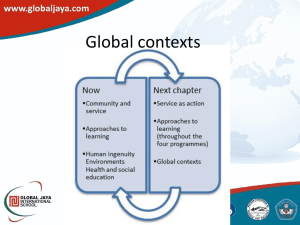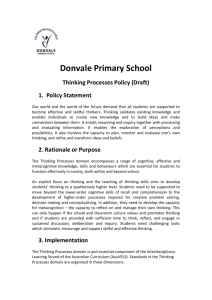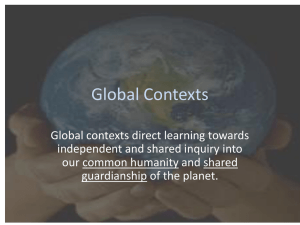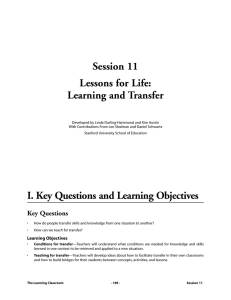Bransford JD, Brown AL, Cocking RR, eds
advertisement
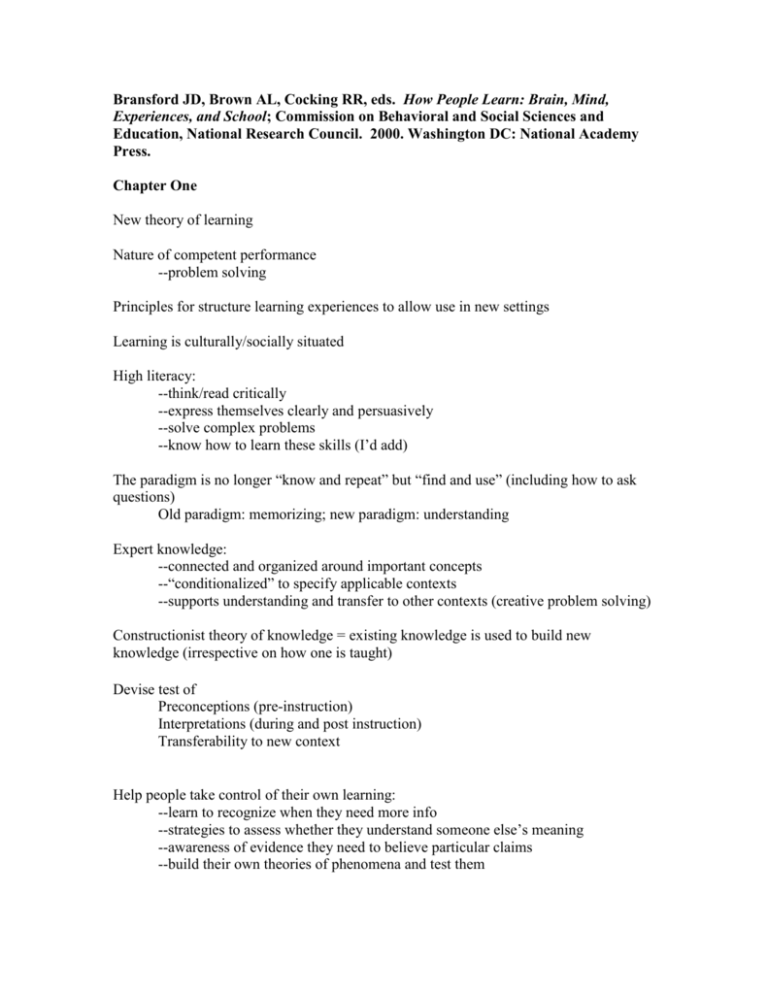
Bransford JD, Brown AL, Cocking RR, eds. How People Learn: Brain, Mind, Experiences, and School; Commission on Behavioral and Social Sciences and Education, National Research Council. 2000. Washington DC: National Academy Press. Chapter One New theory of learning Nature of competent performance --problem solving Principles for structure learning experiences to allow use in new settings Learning is culturally/socially situated High literacy: --think/read critically --express themselves clearly and persuasively --solve complex problems --know how to learn these skills (I’d add) The paradigm is no longer “know and repeat” but “find and use” (including how to ask questions) Old paradigm: memorizing; new paradigm: understanding Expert knowledge: --connected and organized around important concepts --“conditionalized” to specify applicable contexts --supports understanding and transfer to other contexts (creative problem solving) Constructionist theory of knowledge = existing knowledge is used to build new knowledge (irrespective on how one is taught) Devise test of Preconceptions (pre-instruction) Interpretations (during and post instruction) Transferability to new context Help people take control of their own learning: --learn to recognize when they need more info --strategies to assess whether they understand someone else’s meaning --awareness of evidence they need to believe particular claims --build their own theories of phenomena and test them metacognition = ability to --predict performance on tasks --monitor current levels of mastery/understanding Teaching approaches should focus on: --sense-making --self-assessment --reflection (what worked, what needs improving) Expert performance: --see patterns, relationships, and discrepancies --conceptual understanding that lets experts extract level of meaning from info not apparent to novices --help them select/remember information and identify what is relevant --meta-cognitive monitoring (see p. 18 for details) Metacognition to teach: Goals: independence and self-regulation Skills: --predict outcomes --explain to oneself to improve understanding --note failure to comprehend --activate background knowledge --plan ahead --apportion time and memory frequent formative assessment --make student thinking visible to ourselves, peers, teacher --tap understanding vs. ability to repeat facts or perform isolated skills students’ theories of intelligence – fixed or malleable? Universal or situational? What does mastery look like? “Doing with understanding” Chapter Two – Experts vs. novices “expertise” = greater problem-solving ability experts organize problems and information into organized conceptual structures/schemas experts notice features and meaningful patterns of information that are not noticed by novices experts have acquired a great deal of content knowledge that is organized in ways that reflect a deep understanding of their subject matter experts knowledge cannot be rescued to sets of isolated facts or propositions but, instead, reflects contexts of applicability; that is, the knowledge is conditionalized on a set of circs experts are able to flexibly retrieve important aspects of their knowledge with little attentional efforts though experts know their disciplines thoroughly, this does not guarantee that they are able to teach others experts have varying levels of flexibility in their approach to new situation curriculum should be organized in ways that lead to conceptual understanding/structuring assessment: assess degree to which students’ knowledge is “conditionalized” (ability to specify the contexts in which a certain idea or knowledge will be useful) 110: synthesizing and summarizing – help students understand why we do this, what rhetorical function do these serve? How does it increase persuasion? Various strategies within each task. Contextualize these tasks. Pattern recognition triggering relevant conditions Exercise: Pick out the measurement statements Data versus interpretation Instruction should focus on speeding pattern recognition p. 48: adaptive experts: approach new situations flexibly learn throughout lifetime use what they’ve learned questions current understanding and attempt to move beyond it Chapter 3: Learning and Transfer Key characteristics of transfer (p. 53) Initial learning is necessary for transfer, and a considerable amount is known about the kinds of learning experiences that support transfer Knowledge that is overly contextualized can reduce e transfer, abstract represents of knowledge can help promote transfer Transfer is best viewed as an active dynamic process rather than a passive endproduct of a particular set of learning experiences All new learning involves transfer based on previous learning, and this fact has important implications for the design of instruction that helps student learn Structure-function relationship 110 revision exercise: use syntactic rules to revise a paragraph. First: ID important ideas (use syntax rules to identify important ideas in the reading. Summarize these details.) 110 revision exercise: give ambiguous sentence (e.g., “But they didn’t even tell them they were going” and then ask them to build a coherent paragraph that ends in this sentence). 110 paper: contrasting cases: intelligent design vs. Darwin empirical vs. non-empirical skeptical vs. faith K vs. values Material vs. nonmaterial explanations What is science? Student motivation is important: performance oriented (reluctant to take risks/make mistakes) vs. learning oriented Motivators: Feeling that they are contributing to others Usefulness of task Context in promoting transfer: Teaching in multiple contexts facilitates transfer Ask learners to solve a specific case and then provide them with an additional, similar case –encourage them to abstract general principles that they can use in both problems Let students learn in a specific context and then help them engage in ‘what if’ problem solving designed to increase the flexibility of their understanding Generalize the case so that learners are asked to create a solution that applies not simply to a single problem, but to a whole class of related problems Transfer is an issue of assessment as well as instruction – relationship between what is learned and what is tested Ask students to represent experiences at levels of abstraction that transcend specific context to assess transfer, measure speed of learning of novel contexts, not early performance attempts See p. 64 for “flexible transfer” exercise/test Evidence as a transfer issue – claim/support relationship across contexts Goal of education: enhance transfer so students better understand nonschool environments in which they must function explore ways to help student develop adaptive expertise 110: metacognitive pretest – ask students about their goals and their presumptions about education Are the performance-oriented or learning oriented? What would an “expert performance” in writing biology look like? What is their attitude about the place of writing in disciplinary courses? Read Maienschein -- summarize scientific literacy skills; turn in at beginning of class -- then, at end of semester, give same instrument 355: First, look at DNR wildlife action/management plan – align 355 goals with community and ensure students understand how data will help community Then: self-guided observation trip note a phenomenon devise a hypothesis (can be from another investigator – from reading) devise a method to test 110: Scientists’ assumptions about significance (in the “importance” sense)– how can we read for clues about this – what details are significant/relevant o look at controversies – what issues do they touch on? Ascertain legitimacy of procedures by referring to known scientific principles how can we structure our writing to address these issues? Let students produce rules for determining scientific significance Scientific education: provide environment so that students can construct scientific understandings by iterative process of Theory building Criticism Refinement based on their own questions, hypotheses and data analysis activities Question posing Argumentation Students: Explore implications of the theories they held Examine underlying assumptions Formulate and test hypotheses Develop evidence Negotiate conflicts in belief and evidence Argue alternative interpretations Warrant for conclusions For assessment (110, 355, citizens): ask learners to think aloud about open-ended realworld problems (Pre- and post-learning) 4 principles for design of an effective learning environment: learner centered – teachers build on knowledge students bring to learning situation knowledge centered – teachers help students develop an organized understanding of important disciplinary concepts assessment centered – teachers help make student thinking visible so ideas can be discussed and clarified; by having student present arguments in debates, discuss solutions to problems at qualitative level, and make predictions about phenomena (instrument must be sensitive to comprehension and understanding vs. memorization) community centered – teachers establish classroom norms that value learning with understanding and students feel free to explore what they do not understand expert teacher characteristics: firm understanding of own discipline knowledge of common student conceptual barriers (student cognitive roadmap to guide assignments) knowledge of effective strategies for working with students Bransford JD, Donovan MS. Scientific Inquiry and How People Learn. In Bransford JD, AL Brown and RR Cocking, eds., How People Learn: Brain, Mind, Experience and School. Washington DC: National Academies Press. 2003; 387-590. Guidelines for science education emphasize: Familiarity with discipline’s concepts, theories, models Understanding of how K is generated and justified Ability to use these understandings to engage in new inquiry Metacognition = learning monitoring and critiquing their own claims and learning; asking learners to reflect and explain what they’re doing and why Developmental sequence of scientific knowledge: Stage 1: K =correct/incorrect facts Stage 2: K = “mere opinion” Stage 3: K = interpretations informed by evidence Typical student conceptions of knowledge generation and justification that must be addressed: Help students develop a conception of experimentation as testing ideas rather than trying things out to produce a desired outcome Students overlook need to hold all but one variable constant Students attend only to confirmatory evidence; they ignore/distort evidence that doesn’t conform to their beliefs Believe models are “physical copies” of reality, not conceptual concepts Don’t understand that you can test models by comparing their implications to actual observations Don’t know that changing model means adding new information or replacing the wrong component Believe correlation = cause Believe single instances are determinant Will accept arguments based on inadequate sample sizes, causality from contiguous events, conclusion from statistically insignificant differences See p. 409 for methods evaluation exercise Students need to learn to distinguish fact from theory (interpretation) Learning science involves Observation Imagination Reasoning about phenomena under study Framework for evaluating quality of inquiry Understanding main ideas Understanding inquiry process Being inventive Being systematic Reasoning carefully Applying tools of research Using teamwork Communicating well (learning scientific norms concerning data, explanation, causal models, relationships) Model = a set of propositions which can be confirmed/disconfirmed Model assessment (Possible criteria for assessment) Explanatory power Predictive power Internal consistency (with all aspects of the model) External consistency (with common experience) To learn scientific process, learners must have opportunities to Use prior knowledge to pose problems and generate data Search for patterns in data Develop causal models to account for data Use patterns in data to make predictions Make ideas public and revise initial models in light of anomalous data and in response to critiques Inferences = what’s observed (data) + prior knowledge/beliefs conclusions Common misconceptions in evolution Nature is purposeful, not random Variation (continuous) --there is a wide range of variability in populations Role of supernatural forces Lamarckian ideas (change due to needs of organism in extended exposure to environment will result in morphological changes that will be passed on to next generation) 110: Sunflower seed assignment Count stripes on sunflower seeds – What counts as a stripe? Count one side or both? Can they write operational definitions that will enable another group to replicate counts? 110: compare current model of germ theory to humors model of disease 110: research proposal to test hypothesis – write M&M and justifications of significance of project – break down methods into component parts (objective, operational definition, procedures) Scientists are more persuaded by the absence of disproving evidence than the presence of confirmatory evidence – e.g., black swan problem. Engaging resilient preconceptions: Draw on knowledge/experiences not generally activated by topic Provide opportunities for students to experience discrepant events that allow them to come to terms with shortcomings of everyday models Provide narrative accounts of discovery (targeted) knowledge of the development of (targeted) tools Organizing knowledge around core concepts of a discipline Standards of evidence What constitutes proof and disproof Modes of reasoning Modes of inquiry Supporting metacognition Monitoring (across-group) of consistency between explanation and theory Both group work + individual reflection work best



